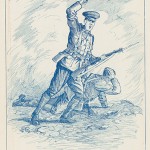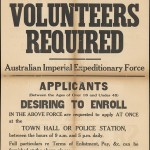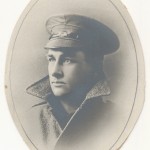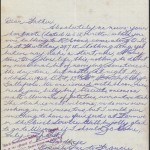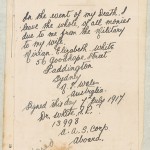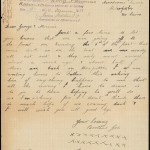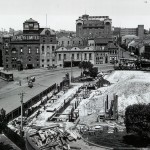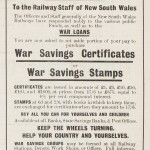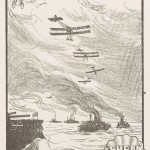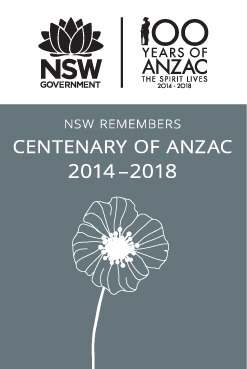Research using NSW State Archives resources
State Archives holds many records relating to World War IThis Guide will help identify research pathways for tracing the stories of New South Wales soldiers and nurses, as well as highlighting a number of resources from our collection that provide background information to life on the home front during World War I.
- Voice from the Dardanelles leaflet. From NRS 12060 [9/4705 letter 15/7546]
- Volunteers Required. From NRS 12060 [9/4702 letter 14/7341]
- Skeen Wallis, rock drill driver at Sydney Harbour Trust, died 17 July 1918. Digital ID 20231_a43_000032
Government Employees
Many service men and women worked as public servants prior to World War I, and many were employed in the Public Service upon their return home. Official figures published in annual reports of NSW Government departments soon after the end of World War I, show that there were at least 11,033 Government employees who were granted military leave from 1914-1918. This number comprises 8,477 Railways and Tramways employees,[1] 2,336 public servants (those employed under the provisions of the Public Service Act),[2] and 217 from the Police Department.[3] The figures include both permanent and temporary employees, but exclude casual and contract staff of which there are no known official figures for the period. It is important to note that not all of those who were granted leave were accepted into the military, and not all those who were accepted were sent abroad.
Of the 11,033 government employees listed, 1,659 of them were killed in action, with the highest number predictably coming from Railway and Tramway employees (1,210),[4] followed by public servants (400),[5] and policemen (49)[6]. According to departmental annual reports, the total number of Government employees including public servants, police, and railways/tramways employees up to 30 June 1919, was 66,362.
Our online index, NSW Government employees granted military leave 1914-1918, includes approximately 10,000 individual names across 13,134 entries. These details were taken from resources and records held at State Archives’ Western Sydney Records Centre.
See the following fact sheets and guides on our website for more information about records relating to public servants:
Further information relating to public servants on military service can often be located in the records of various government departments, especially in correspondence records such as letters received and letters sent. NRS 10958 Police Gazettes include regular updates of officers who enlisted and were later wounded or killed. NRS 12922 Railway Personal History Cards include details of military service and participation in the 1917 Strike. NRS 9873 contains photographs of doctors from 1888 to 1927 and may include doctors who served in World War I or became doctors when they returned.
Below are examples of record series in our collection which detail military service by public servants:
| NRS 13986 | Register recording the difference between military and civil pay received by officers and employees of the Sydney Harbour Trust | 1914-1919 |
| NRS 73 | Register of military pay: Register of officers on extended military leave, Department of Agriculture | 1915-19 |
| NRS 14556 | Military Leave files, Water Conservation and Irrigation Commission | 1916-1943 |
| NRS 334 | Printed copies of Cabinet and Public Service Board decisions re military pay to officers enlisting | 1914-19 |
| NRS 15319 | Teacher Leave cards, Department of Education | 1908-45 |
| NRS 4078 | Records of teachers and officers in the A.I.F. during World War I, Department of Education | 1914-40 |
| NRS 15905 | Nominal Roll of the First Railway Section, Australian Imperial Expeditionary Forces (AIF) | 1917-20 |
Details about military service can also be located in the annual reports of the various government departments. These reports were often published in the Parliamentary Papers, many of which have been included in our online index, NSW Government employees granted military leave 1914-1918.
Probates and Deceased Estates
- Letter from the front. NRS 13660 4-71768, Lawrie Joseph D’Arcy Fowler
- Soldier’s will. NRS 13660 4-89085, White
- Heading off to the front. NRS 13660 4 84888, Robinson
We provide access to the probate packets for people who died during the war period 1914-18. Probate packet item numbers are searchable in our catalogue. The probate index is also available at the Western Sydney Records Centre (WSRC). For more details see Probate Packets Guide.
Deceased estates files can be found for some soldiers. You can search our Online Index for Deceased Estate files by name or enter “Australian Imperial Forces” in the locality search field.
Find My Past
Find My Past have digitised and indexed the NSW Will Books for the World War I period. Free access to Find My Past is available at the Western Sydney Records Centre. Microfilm copies of the Will Books can be viewed at the Western Sydney Records Centre. For more information about Will Books see NRS 13661 Will Books.
War brides and divorce
Many Australian service men arrived home with British wives. Perhaps the most infamous war bride to make her way to Sydney was Tilly Devine. You can check for arrivals in NSW of British wives on the Inward Passenger Lists 1918-1920 (microfilms 2100- 2114). The microfilm are are available in the Western Sydney Records Centre.
Some war-time marriages may have ended in divorce. See Divorce Records Guide for how to locate divorce records. Court reporting transcripts can also be a valuable resource for divorce cases. See NRS 2713, Transcripts of evidence of the various Courts and Royal Commissions and Boards of Inquiry for more details.
Soldier Settlement records
The Returned Soldiers Settlement Act, 1916 (Act No 21, 1916) made provision for the dispersing of land to returned soldiers. Subsequently, vast tracts of NSW were settled by returned servicemen and women.
You can name search a number of Online Indexes for record series relating to Soldier Settlements in NSW on our website. Photographs of a number of Soldier Settlement estates throughout the State can be searched on Photo Investigator.
For more information visit A Land Fit for Heroes?, a website dedicated to the memory of Soldier Settlement in NSW. This website includes a number of case studies that demonstrate what life was like living on Soldier Settlements.
The Soldier Settlement indexes are also included in NSW State Archives’ Open Data Project. The aim of this project is to identify data sets relating to the NSW State Archives collection and publish them in accessible ways. Data published by this project could spark new interfaces to the collection, create new possibilities for federated searching, or allow creative re-purposing such as in visualisations or in applications. Read more on the GovHack website.
Additional records
- Installing the railway gun at Central Railway Station. Digital id 17420_a014_a014001459
- Buy war savings certificates. From NRS 15298 [1/426, opposite p.4]
- Shell Benzine advertisement. From NRS 15298 [1/426, opposite p.17]
NSW State Archives holds a number of records that may contain information about World War I and individual people. Our Guides and Indexes search option allows researchers to access all our subject guides and search options in one place. Other records series that may be of interest include:
Premier’s Department
The NSW Premier’s Department was established as a separate entity in 1914. It acted as the main link between the people of the state on the one hand, and the Commonwealth Government on the other. It was also responsible for any business arising from the two NSW Houses of Parliament, any foreign correspondence and the Agency-General in London. During World War I the Premier’s Department also liaised with Commonwealth based military bodies and other agencies concerned with the arrangement and execution of activities and functions associated with the war effort. New activities for the department at this time included the State War Council of NSW, the NSW Aviation School, and the NSW Munitions Committee.
For more details and research on war time activities of the Premier’s Department see:
- NRS 12062 Indexes and registers of letters received
- NRS 12060 Letters received
- NRS 12061 Letters received Special Bundles
- NRS 12172 Unregistered papers and pamphlets
Chief Secretary
In 1859 new administrative arrangements for the NSW Government referred to the Colonial Secretary as Chief Secretary to the Government. Although the official ministerial title did not change until 1959, the name Chief Secretary was commonly used. For the period of World War I the records of the Chief Secretary contain papers relating topics such as: electoral reform, theatre regulations, administration of racing, health matters and the protection of fisheries and fauna. In many cases the work of the Chief Secretary’s Department paralleled and sometimes crossed Departmental boundaries.
For more details and research on war time activities of the Chief Secretary’s Department see:
- Index to the Main series of letters received 1826-1982
- NRS 905 Main series of letters received
- NRS 906 Chief Secretary Special Bundles
Department of Attorney General and Justice
In 1911 the Department of Attorney General and of Justice was divided into two branches: the Justice Branch and the Attorney General’s Branch. The Justice Branch was responsible for the Offices of Equity, Bankruptcy, Sheriff, Probate and Intestate Estates, and the Registrar General, as well as the Courts of Petty Sessions, Registrars of District Courts, Coroners, and Gaol and Penal Establishments. For the period of World War I records relating to the granting of military leave to public servants and the treatment of aliens can also be found.
For more details and research on war time activities of the Attorney General and Justice see:
Railway Budget magazine
The Railway Institute published a series of magazines for the information and entertainment of Railway staff. The publication underwent a number of title changes, beginning as the NSW Railway Budget in 1892, renamed the NSW Railway & Tramway Budget on 1 March 1912 and finally being renamed the NSW Railway & Tramway Magazine on 1 December 1917. The magazine contains regular articles on Railway staff enlisting, Honor Rolls, letters and photos from the Front along with a variety of poetry and songs.
For more details and research on the Railway Budget see:
- NRS 15298 NSW Railway Budget magazine – includes letters and photos from soldiers and war related articles
Public Instruction/Education Gazette
The Department of Education produced a monthly periodical called the Public Instruction (later Education) Gazette (later Education) of which several copies were sent to all schools. In 1915 over 4,000 copies were being distributed across NSW each month. The Gazette contains some images and information relating to NSW schools during the war, such as patriotic fundraising activities. Some photographs of teachers as well as honour rolls are also printed within the gazette volumes:
- AK 698 Public Instruction/Education Gazette 1891-1973
Mental health facilities
- Broughton Hall, No. 13 Auxiliary Military Hospital – used from 1915 for the treatment of returned soldiers suffering from shell shock and other nervous disorders. Please note all patient identifying records are Closed to Public Access for 110 years. See Mental Health Facilities Guide for details relating to accessing mental health patient records.
References
[1] Parliamentary Papers, 1919, Vol. 4, NSWGR&T, Report of the Commissioners for the Year Ended 30th June, 1919, p. 22
[2] Parliamentary Papers, 1920, Vol. 4, Public Service Board, Annual Report for the Year Ended 30th June, 1919, p. 18
[3] Parliamentary Papers, Second Session 1920, Vol. 3, Police Department, Annual Report for the Year Ended 31st December, 1919, p. 5
[4] Parliamentary Papers, 1921, Vol. 3, NSWGR&T, Report of the Commissioners for the Year Ended 30th June, 1921, p. 18
[5] Parliamentary Papers, Second Session 1920, Vol. 4, Public Service Board, Annual Report for the Year Ended 30th June, 1919, p. 18
[6] Parliamentary Papers, Second Session 1920, Vol. 3, Police Department, Annual Report for the Year Ended 31st December, 1919, p. 5

